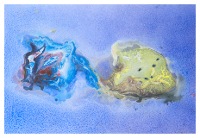Conveners
Parallel III: C1 Heavy Quarks: Charmonium-Like States, Exotics, Hybrids, Diquarks
- Antonio Vairo (Institut fuer Theoretische Physik-Ruprecht-Karls-Universitaet H)
Jaume Tarrus Castella
(Technische Universität München)
08/09/2014, 16:30
Section C: Heavy Quarks
During the past years experimental observations have revealed the existence of a large number of states above open flavor thresholds that can not be identified as standard heavy quarkonium states. In this talk we discuss the possibility that some of these states are heavy quarkonium hybrids. Heavy quarkonium hybrids are states formed by a heavy quark-antiquark pair in a color octet...
Takayuki Matsuki
(Tokyo Kasei University)
08/09/2014, 16:50
Section C: Heavy Quarks
In the past decade, many of charmoniumlike and bottomoniumlike states have been reported in experiments, which have led us to extensive discussions on the underlying structure of these states. We would like to address the possibility to explain these structures by hadronic one-loop diagrams, which may correspond to recapitulate threshold effects. Starting from charged XYZ states, we also apply...
Sasa Prelovsek
(University of Ljubljana)
08/09/2014, 17:10
Section C: Heavy Quarks
I will present the first evidence for the existence of the charged charmonium-like Zc+ from lattice QCD. The results on the other charmonium and charmonium-like states will also be reviewed.
Anton Trunin
(BLTP JINR)
08/09/2014, 17:30
Section C: Heavy Quarks
On the basis of perturbative QCD and relativistic quark model we calculate cross sections of pair double heavy diquarks production in proton-proton interaction. Both, nonrelativistic and relativistic results are obtained. Relativistic factors in the production amplitude connected with the relative motion of heavy quarks and the transformation law of the bound state wave function to the...
Melahat Bayar
(Kocaeli University)
08/09/2014, 17:50
Section C: Heavy Quarks
We present a study of the many-body interaction between a $D^*$ and multi-$\rho$. We use an extrapolation to SU(4) of the hidden gauge formalism, which produced dynamically the resonances $f_2(1270)$ in the $\rho\rho$ interaction and $D^*_2(2460)$ in the $\rho D^*$ interaction. Then let a third particle, $\rho$, $D^*$, or a resonance collide with them, evaluating the scattering amplitudes in...
